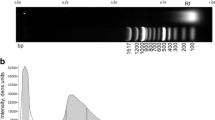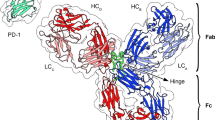Abstract
Antibodies to DNA play an important role in the pathogenesis of autoimmune diseases. The elucidation of structural mechanisms of both the antigen recognition and the interaction of anti-DNA antibodies with DNA will help to understand the role of DNA-containing immune complexes in various pathologies and can provide a basis for new treatment modalities. Moreover, the DNA-antibody complex is an analog of specific intracellular DNA-protein interactions. In this work, we used in silico molecular dynamic simulations of bimolecular complexes of the dsDNA segment containing the Fab fragment of an anti-DNA antibody to obtain the detailed thermodynamic and structural characteristics of dynamic intermolecular interactions. Using computationally modified crystal structure of the Fab-DNA complex (PDB ID: 3VW3), we studied the equilibrium molecular dynamics of the 64M-5 antibody Fab fragment associated with the dsDNA fragment containing the thymine dimer, the product of DNA photodamage. Amino acid residues that constitute paratopes and the complementary nucleotide epitopes for the Fab-DNA construct were identified. Stacking and electrostatic interactions were found to play the main role in mediating the most specific antibodydsDNA contacts, while hydrogen bonds were less significant. These findings may shed light on the formation and properties of pathogenic anti-DNA antibodies in autoimmune diseases, such as systemic lupus erythematosus associated with skin photosensitivity and DNA photodamage.
Similar content being viewed by others
Abbreviations
- dsDNA:
-
double-stranded DNA
- RMSF:
-
Root Mean Square Fluctuations of atoms
- CDR:
-
complementary determining region for antigen recognition
- MD:
-
molecular dynamics
- SLE:
-
systemic lupus erythematosus
References
Hahn B.H. 1998. Antibodies to DNA. N. Engl. J. Med. 338, 1359–1368.
Yung S., Chan T.M. 2008. Anti-DNA antibodies in the pathogenesis of lupus nephritis: The emerging mechanisms. Autoimmun. Rev. 7, 317–321.
Greenspan N., Lu M., Shipley J., Ding X., Li Q., Sultana D., Kollaros M., Schreiber J.R., Fu P., Putterman C., Emancipator S.N. 2012. IgG3 deficiency extends lifespan and attenuates progression of glomerulonephritis in MRL/lpr mice. Biol. Direct. 7, 3–17.
Krishnan M.R., Wang C., Marion T.N. 2012. Anti- DNA autoantibodies initiate experimental lupus nephritis by binding directly to the glomerular basementmembrane in mice. Kidney Int. 82, 184–192.
Ito S., Toyoda K. 2006. Bispecific Abs against modified protein and DNA with oxidized lipids. Proc. Natl. Acad. Sci. U. S. A. 103, 6160–6165.
Herron J.N., He X.M., Ballard D.W., Blier P.R., Pace P.E., Bothwell A.L.M., Voss E.W., Edmundson A.B. 1991. An autoantibody to single-stranded DNA: comparison of the three-dimensional structures of the unliganded Fab and a deoxynucleotide-Fab complex. Proteins. 91, 159–175.
Mol C., Muir A., Cygler M., Lee J.S., Anderson W.F. 1994. Structure of an immunoglobulin Fab fragment specific for triple-stranded DNA. J. Biol. Chem. 269, 3615–3622.
Pokkuluri P., Bouthillier F., Li Y., Kuderova A., Lee J., Cygler M. 1994. Preparation, characterization and crystallization of an antibody Fab fragment that recognizes RNA. Crystal structures of native Fab and three Fab-mononucleotide complexes. J. Mol. Biol. 243, 283–297.
Yokoyama H., Mizutani R., Satow Y., Komatsu Y., Ohtsuka E., Nikaido O. 1999. Crystal structures of the 64M-2 and 64M-3 antibody Fabs complexed with DNA (6-4) photoproducts. Nucl. Acids Symp. Ser. 42, 267–268.
Yokoyama H., Mizutani R., Satow Y., Komatsu Y., Ohtsuka E., Nikaido O. 2000. Crystal structure of the 64M-2 antibody Fab fragment in complex with a DNA dT(6-4)T photoproduct formed by ultravioletradiation. J. Mol. Biol. 299, 711–723.
Kobayashi H., Morioka H., Tobisawa K., Torizawa T., Kato K., Shimada I., Nikaido O., Stewart J.D., Ohtsuka E. 1999. Probing the interaction between a highaffinity single-chain Fv and a pyrimidine (6-4) pyrimidone photodimer by site-directed mutagenesis. Biochemistry. 38, 532–539.
Kabat E.A., Wu T.T., Perry H.M., Gottesman K.S., Foeller C. 1991). Sequences of Proteins of Immunological Interest, 5th ed. NIH Publication no. 91-3242.
Phillips J.C., Braun R., Wang W., Gumbart J., Tajkhorshid, E., Villa E., Chipot C., Skeel R.D., Kale L., Schulten K. 2005. Scalable molecular dynamics with NAMD. J. Comput. Chem. 26, 1781–1802.
MacKerel A., Bashford D., Bellott M., Dunbrack R. L., Evanseck J.D., Field M. J., Fischer S., Gao J., Guo H., Ha S., Joseph-McCarthy D., Kuchnir L., Kuczera K., Lau F.T.K., Mattos C., et al. 1998. All-atom empirical potential for molecular modeling and dynamics studies of proteins. J. Phys. Chem. B. 102, 3586–3616.
Foloppe N., MacKerell Jr.A. 2000. All-atom empirical force field for nucleic acids: 1. Parameter optimization based on small molecule and condensed phase macromolecular target data. J. Comput. Chem. 21, 86–104.
Humphrey W., Dalke A., Schulten K. 1996. VMD: Visual molecular dynamics. J. Mol. Graph. 14, 33–38.
DePristo M.A., de Bakker P.I., Blundell T.L. 2004. Heterogeneity and inaccuracy in protein structures solved by X-ray crystallography. Structure. 12, 831–838.
Fraser J.S. 2011. Accessing protein conformational ensembles using room-temperature X-ray crystallography. Proc. Natl. Acad. Sci. U. S. A. 108 (39), 16247–16252.
Berman H., Westbrook J., Feng Z., Gilliland G., Bhat T., Weissig H. 2000. The protein data bank. Nucleic Acids Res. 28, 235–242.
Burnley B.T., Afonine P.V., Adams P.D., Gros P. 2012. Modelling dynamics in protein crystal structures by ensemble refinement. eLife, 1, e00311.
Hummer G., Schotte F., Anfinrud P. 2004. A Unveiling functional protein motions with picosecond X-ray crystallography and molecular dynamics simulationsò. Proc. Natl. Acad. Sci. U. S. A. 101, 15330–15334.
Wall M., van Benschoten A., Sauter N.K., Adams P.D., Fraser J.S., Terwilliger T.C. 2014. Conformational dynamics of a crystalline protein from microsecondscale molecular dynamics simulations and diffuse X-ray scattering. Proc. Natl. Acad. Sci. U. S. A. 111, 17887–17892.
Stuart L., Hughes J. 2002. Apoptosis and autoimmunity. Nephrol. Dial. Transplant. 17, 697–700.
McHugh N.J. 2002). Systemic lupus erythematosus and dysregulated apoptosis: What is the evidence? Rheumatology. 41, 242–245.
Frese S., Diamond B. 2011. Structural modification of DNA: A therapeutic option in SLE? Nat. Rev. Rheumatol. 7, 733–738.
Su K.Y., Pisetsky D.S. 2009. The role of extracellular DNA in autoimmunity in SLE. Scand. J. Immunol. 70, 175–183.
Pisetsky D.S. 2013. Standardization of anti-DNA antibody assays. Immunol. Res. 56, 420–424.
Yokoyama H., Mizutani R., Satow Y. 2013. Structure of a double-stranded DNA (6-4) photoproduct in complex with the 64M-5 antibody Fab. Acta Cryst. D69, 504–512.
Truglio J.J., Karakas E., Rhau B., Wang H., Dellavecchia M.J., van Houten B., Kisker C. 2006. Structural basis for DNA recognition and processing by UvrB. Nat. Struct. Mol. Biol. 13, 360–364.
Skorvaga M., Theis K., Mandavilli B.S., Kisker C., van Houten B. 2002. The beta-hairpin motif of UvrB is essential for DNA binding, damage processing, and UvrC-mediated incisions. J. Biol. Chem. 277 (2), 1553–1559.
Moolenaar G., Hoglund L., Goosen N. 2001. Clue to damage recognition by UvrB: Residues in the betahairpin structure prevent binding to non-damaged DNA. EMBO J. 20, 6140–6149.
Rosen A., Casciola-Rosen L. 2009. Autoantigens in systemic autoimmunity: Critical partner in pathogenesis. J. Intern. Med. 265, 625–631.
Waters S.T., McDuffie M., Bagavant H., Deshmukh U.S., Gaskin F., Jiang C., Tung K., Fu S.M. 2004. Breaking tolerance to double stranded DNA, nucleosome, and other nuclear antigens is not required for the pathogenesis of lupus glomerulonephritis. J. Exp. Med. 199, 255–264.
Waris G., Alam K. 2004. Immunogenicity of superoxide radical modified-DNA: Studies on induced antibodies and SLE anti-DNA autoantibodies. Life Sci. 75, 2633–2642.
Evans M., Cooke M., Akil M., Samanta A., Lunec J. 2000. Abberant processing of oxidative DNA damage in systemic lupus erythematosus. Biochem. Biophys. Res. Commun. 273, 894–898.
Kuroda D., Shirai H., Jacobson M.P., Nakamura H. 2012. Computer-aided antibody design. Protein Eng. Des. Sel. 25, 507–522.
Behrendt M., Partridge L., Griffiths B., Goodfield M. 2003. The role of somatic mutation in determining the affinity of anti-DNA antibodies. Clin. Exp. Immunol. 31, 182–189.
Jang Y.J., Stollar B.D. 2003. Anti-DNA antibodies: aspects of structure and pathogenicity. Cell. Mol. Life Sci. 60, 309–320.
Cerutti M.L., Centeno J.M., Goldbaum F.A., de Prat- Gay G. 2001. Generation of sequence-specific, high affinity anti-DNA antibodies. J. Biol. Chem. 16, 12769–12773.
Kozyr A., Kolesnikov A., Khlyntseva A., Bogun A., Savchenko G., Shemyakin I., Gabibov A.G. 2012. Role of structure-based changes due to somatic mutation in highly homologous DNA-binding and DNA-hydrolyzing autoantibodies exemplified by A23P substitution in the VH domain. Autoimmune Dis. 2012, 683829. doi 10.1155/2012/683829
Zein H., El-Sehemy A., Fares M, ElHefnawi M., da Silva J.T.A., Miyatake K. 2011. Generation, characterization, and docking studies of DNA-hydrolyzing recombinant Fab antibodies. J. Mol. Recognit. 24, 862–874.
Avnir Y., Tallarico A.S., Zhu Q., Bennett A.S., Connelly G., Sheehan J., Sui J., Fahmy A., Huang C., Cadwell G., Bankston L.A., McGuire A.T., Stamatatos L., Wagner G., Liddington R.C., Marasco W.A. 2014. Molecular signatures of hemagglutinin stem-directed heterosubtypic human neutralizing antibodies against influenza A viruses. PLoS Pathogens. 10, e1004103.
Akiba H., Tsumoto K. 2015. Thermodynamics of antibody–antigen interaction revealed by mutation analysis of antibody variable regions. J. Biochem. 158 (1), 1–13. doi 10.1093/jb/mvv049
Saul F.A., Alzari P.M. 1996. Crystallographic studies of antigen–antibody interactions. Methods Mol. Biol. 66, 11–23.
Sundberg E.J. 2009. Structural basis of antibody–antigen interactions. Methods Mol. Biol. 524, 23–36.
Krishnan M.R., Marion T.N. 1998. Comparison of the frequencies of arginines in heavy chain CDR3 of antibodies expressed in the primary B-cell repertoires of autoimmune-prone and normal mice. Scand. J. Immunol. 48, 223–232.
Rahman A., Giles I., Haley J., Isenberg D. 2002. Systematic analysis of sequences of anti-DNA antibodies: Relevance to theories of origin and pathogenicity. Lupus. 11, 807–823.
Collis A. V., Brouwer A. P., Martin A. C. 2003. Analysis of the antigen combining site: Correlations between length and sequence composition of the hypervariable loops and the nature of the antigen. J. Mol. Biol. 325, 337–354.
Zheng N., Wilson K., Wang X., Boston A., Kolar G., Jackson S.M., Liu Y.-J., Pascual V., Capra J., Wilson P.C. 2004. Human immunoglobulin selection associated with class switch and possible tolerogenic origins for Cd class-switched B cells. J. Clin. Invest. 113, 1188–1201.
Author information
Authors and Affiliations
Corresponding author
Additional information
Original Russian Text © N.I. Akberova, A.A. Zhmurov, T.A. Nevzorova, R.I. Litvinov, 2016, published in Molekulyarnaya Biologiya, 2016, Vol. 50, No. 3, pp. 509–519.
Rights and permissions
About this article
Cite this article
Akberova, N.I., Zhmurov, A.A., Nevzorova, T.A. et al. Molecular dynamics of immune complex of photoadduct-containing DNA with Fab-Anti-DNA antibody fragment. Mol Biol 50, 442–451 (2016). https://doi.org/10.1134/S0026893316020023
Received:
Accepted:
Published:
Issue Date:
DOI: https://doi.org/10.1134/S0026893316020023




